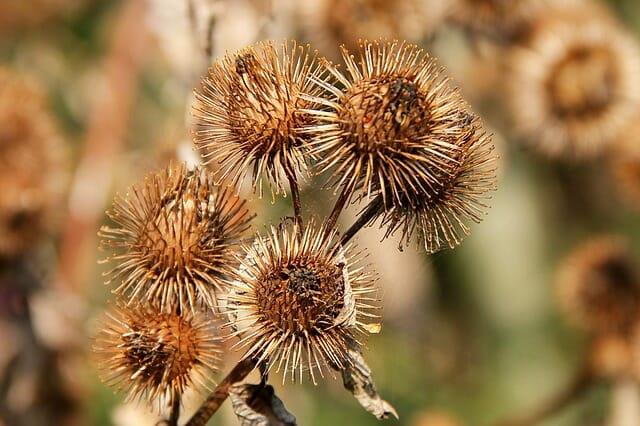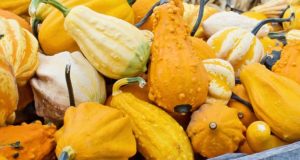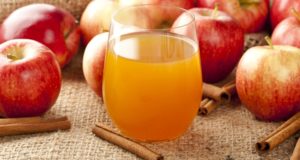From backyard gardens to large-scale farms, fall is often viewed as harvest time. But “nature’s garden” is in full yield in the autumn, too, as the trees begin to lose their leaves and heavy frosts set in.
Following are a few of the highest-yielding, nutritious wild foods that are ready for harvest in the fall. You will need a good plant ID book to make sure you get the right plant. As with foraging at any time, do NOT eat anything you are not 100 percent certain is the correct plant.
Root Crops
Many plants begin to bring their energy into their roots in the fall to wait out the winter underground, in preparation for a growth explosion in the spring. Most root crops can either be dug up with a shovel, or pulled up after loosening the soil around them with the garden fork.
1. Burdock (Arctium species): a variety of burdock has been eaten in Japan for centuries, and with a delicious sweet flavor and a delightful crunchy texture, it’s well worth trying. Burdock should be harvested the fall of their first year (before they produce along central stock with flowers) and can be dried or eaten right away.
2. Chicory (Cichorium intybus): known as an excellent coffee substitute, chicory is best harvested once the top of the plant mostly dies, sending its energy to the roots. It can be roasted and ground into a powder for a delightful tea high in nutrients.
3. Dandelion (Taraxacum species): another potential coffee substitute, dandelion roots are known as a powerful medicine and can be roasted much the same way as chicory. Be careful not to confuse them with chicory, since the leaves look similar.
Nuts
Many nuts are available in the fall, and they are available from year to year under two categories: mast year nut producers, and annual producers. Mast year nuts produce nuts irregularly from year to year, with some years being “mast years” of high production, and other years yielding few or no nuts at all. Many nuts can be harvested simply by waiting until they fall to the ground, particularly after strong winds around the time they are ripe.
Learn The Secrets Of The Word’s Top Survivalists!
One can put a tarp under the tree to catch the nuts during windy periods, knock the branches with a long stick, climb a ladder and shake the branches (or shake the whole tree if small enough), or get a good, solid throwing stick and chuck it at the nuts to dislodge them. Nuts keep longer once dried for two weeks either in a cotton sack (e.g. old pillow case), or on screens, and then roasted. You may also choose to purchase specialized “pickers” for your nuts to pick them up off the ground, which can be purchased online.
4. Acorns (Quercus species): With mast years every 2-3 years, acorns fall when they are ripe in early- to mid-fall, especially during wind events.
5. Walnuts (Juglans species): Irregular mast producers, walnuts may still produce at least some nuts during low-production years. They are both delectable and nutritious, though some species such as black walnut (Juglans nigra) are more difficult to shell, with relatively little nut meat, while others, such as English walnut (Juglans regia) have much bigger nuts with thinner shells. Depending on the species, they ripen throughout the fall. The hulls can be removed by stomping on them and rolling them with your feet, or they can be cut off with a knife by cutting a line around their diameter and removing by hand with a good, thick set of gloves (the hulls will stain your hands). You can then put them in a bucket with a lid, some gravel, and a bit of water, and shake the bucket vigorously to remove hull remnants, followed by a good rinse before drying (old pillow cases hung indoors away from sun work well). Dispose of the hulls by spreading them across the landscape away from gardens, as black walnuts especially can damage soil life and inhibit plant growth.
6. Hickories (Carya ovata, Carya laciniosa, Carya palida, Carya tomentosa, and Carya ovalis): Closely related to pecans, but often sweeter tasting, most hickories produce annually, ripening in the early fall, or late summer. Once dry, husks are easy to remove.
7. Pecans (Carya illinoinensis): Another irregular mast producer, they are usually ready in November, when they fall consistently from the trees. Some trees may have very small nuts that are difficult to remove from shells, though as with other hickories, husks are fairly easy to remove.
8. Hazelnuts (Corylus species): Ripening from late August through September, as with all nuts, you’ll have to beat the squirrels to hazels. Nuts can be found during mast years under the leaves and are easy to remove from the shell.
Other Fall Forage Crops
9. Apples (Malus domestica): There are many wild or untended apple trees growing throughout North America and elsewhere. Once you start looking in the fall, they shouldn’t be hard to spot in a good year. Similar to nuts, many apple trees don’t produce a heavy crop every year. Lower quality apples can be used to make apple chips (simply by cutting and dehydrating), or apple cider.
10. Hackberry / Sugarberry (Celtis species): There are several species of hackberry, many of them containing a delectable and sweet date flavored dark, light brown or orangish berry ready in mid to late fall. One way to harvest them is to wait until the leaves fall from the tree, put a tarp under the tree and shake the tree or branches vigorously. Due to their low moisture and high sugar content, the berries keep quite well without any processing and can be stored in paper bags or simply in a bowl or container that allows excess moisture to escape.
Although there are many other wild foods available for harvest in the fall, this list of higher-yielding foods is a good place to start. Other wild foods to look out for in the fall include rosehips, elderberries, watercress, amaranth seed, ground nut and many others. Fortunately, most plant ID books give a good indication as to the season that a given crop is available, so hopefully this will only be the start of your journey to find the best foods nature has to offer in your area.
If you have your own favorite fall forage crops you like to harvest in the fall, please share in the comments below!
 Off The Grid News Better Ideas For Off The Grid Living
Off The Grid News Better Ideas For Off The Grid Living




